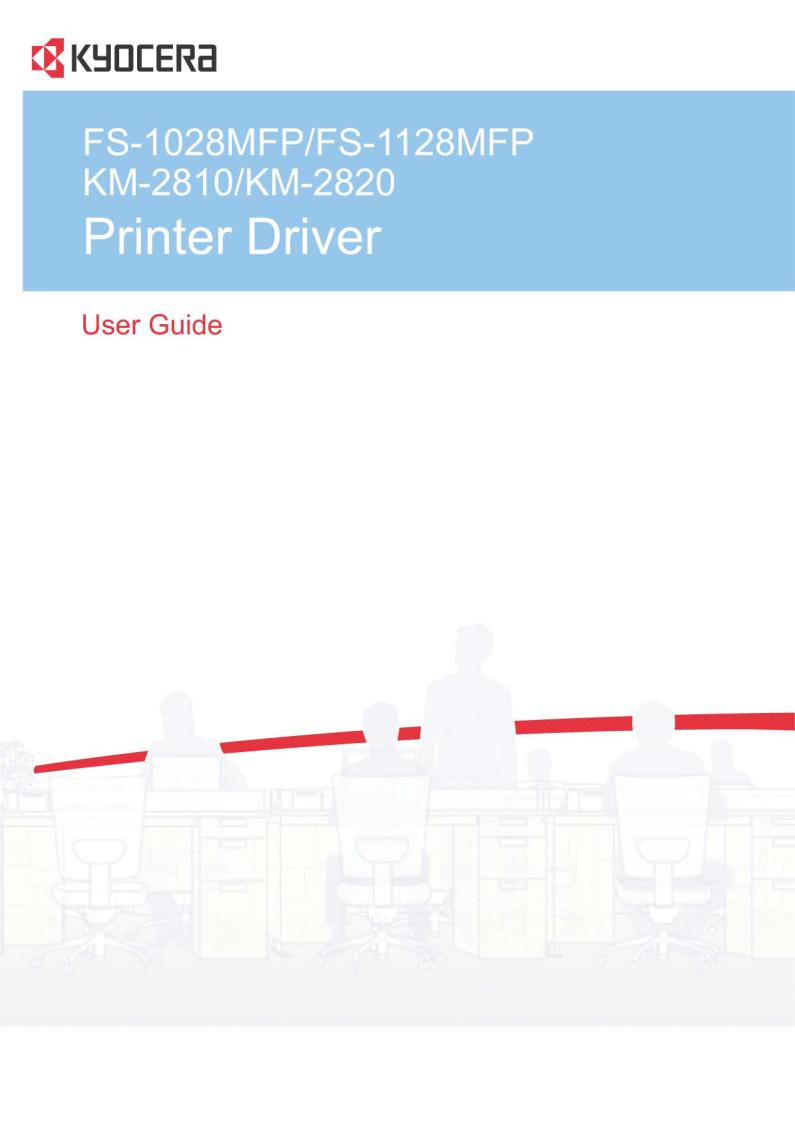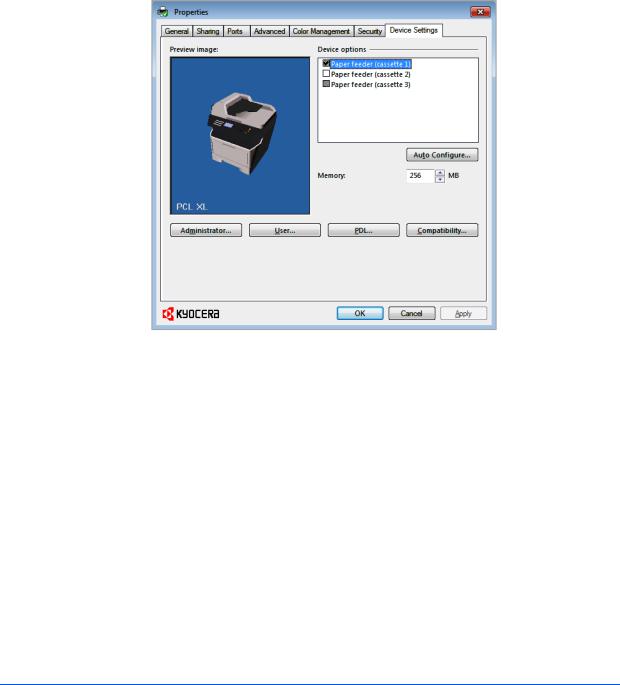Kyocera KM-2810, FS-1128MFP, KM-2820, FS-1028MFP Manual

Legal Notes
Unauthorized reproduction of all or part of this guide is prohibited.
The information in this guide is subject to change for improvement without notice.
We cannot be held liable for any problems arising from the use of this product, regardless of the information herein.
Regarding Trademarks
Microsoft Windows is a registered trademark of Microsoft Corporation in the U.S. and/or other countries. KPDL is a trademark of Kyocera Corporation. PCL is a trademark of Hewlett-Packard Company. TrueType is a registered trademark of Apple Computer, Inc. Adobe, Acrobat, Adobe Reader, Photoshop and PostScript® are trademarks of Adobe Systems, Incorporated.
All other brand and product names herein are registered trademarks or trademarks of their respective companies.
Examples of the operations given in this guide support the Windows 7 printing environment. Essentially the same operations are used for Microsoft Windows Vista, Windows XP, Windows Server 2003, Windows Server 2008 and Windows 2000 environments.
User Interface screen captures shown in this guide may differ depending on your printing device.
This user guide and its contents were developed for the 5.1 driver.
Models supported by the KX printer driver
FS-1028MFP
FS-1128MFP
KM-2810
KM-2820
Copyright © 2010 KYOCERA MITA Corporation
All rights reserved.

Table of Contents
Chapter 1 |
Installation |
|
|
Preparing to Install the Driver ........................................................................................................ |
1-1 |
|
Selecting an Installation Method ................................................................................................... |
1-1 |
|
Installing Utilities ........................................................................................................................... |
1-2 |
|
Upgrading Driver Components ...................................................................................................... |
1-2 |
|
Express Installation ....................................................................................................................... |
1-2 |
|
Installing in Express Mode ....................................................................................................... |
1-2 |
|
Custom Installation ....................................................................................................................... |
1-4 |
|
Installing in Custom Mode with a Network Connection using Discover ................................... |
1-4 |
|
Installing in Custom Mode with a USB Connection using Discover ......................................... |
1-5 |
|
Installing in Custom Mode with a Network Connection using Custom Select .......................... |
1-7 |
|
Installing in Custom Mode with a USB Connection using Custom Select ................................ |
1-8 |
|
Optional Printer Components ........................................................................................................ |
1-9 |
|
Installing Optional Printer Components ................................................................................... |
1-9 |
|
The Add Printer Wizard ............................................................................................................... |
1-10 |
|
Installing a Printer Driver in Windows 7 and Windows Vista .................................................. |
1-10 |
|
Installing a Printer Driver in Windows XP and Windows 2000 ............................................... |
1-10 |
|
Printer Driver Settings Access ..................................................................................................... |
1-11 |
|
Changing the Default Driver Settings .................................................................................... |
1-11 |
Chapter 2 Device Settings
Accessing Device Settings ............................................................................................................ |
2-1 |
Device Options .............................................................................................................................. |
2-2 |
Setting Device Options ............................................................................................................ |
2-2 |
Auto Configure .............................................................................................................................. |
2-2 |
Enabling Auto Configuration .................................................................................................... |
2-2 |
Memory ......................................................................................................................................... |
2-3 |
Setting the Memory ................................................................................................................. |
2-3 |
Administrator Settings ................................................................................................................... |
2-3 |
User Login ............................................................................................................................... |
2-3 |
Job Accounting ........................................................................................................................ |
2-5 |
Show Quick Print Tab .............................................................................................................. |
2-6 |
Send Count Information ........................................................................................................... |
2-7 |
Send Application Name ........................................................................................................... |
2-7 |
Administrator Password .......................................................................................................... |
2-7 |
Associate Profile with Application ............................................................................................ |
2-7 |
Lock Settings ........................................................................................................................... |
2-8 |
SNMP ...................................................................................................................................... |
2-9 |
User Settings .............................................................................................................................. |
2-10 |
Identification .......................................................................................................................... |
2-11 |
Units ...................................................................................................................................... |
2-11 |
Language Preference ............................................................................................................ |
2-11 |
PDL (Page Description Language) ............................................................................................. |
2-11 |
PDL Options .......................................................................................................................... |
2-12 |
PDF Options .......................................................................................................................... |
2-14 |
XPS Driver .................................................................................................................................. |
2-15 |
KX DRIVER |
i |

|
Compatibility Settings ................................................................................................................. |
2-16 |
|
Media Source Enumeration ................................................................................................... |
2-16 |
|
Ignore Application Collation ................................................................................................... |
2-16 |
|
Combine Source and Media Type Lists ................................................................................. |
2-17 |
|
Removing a Plug-in ..................................................................................................................... |
2-17 |
Chapter 3 |
Quick Print |
|
|
Quick Print Options ....................................................................................................................... |
3-1 |
|
Common Printing Options ....................................................................................................... |
3-1 |
|
Collate ..................................................................................................................................... |
3-2 |
|
Duplex Printing ........................................................................................................................ |
3-2 |
|
Multiple Pages per Sheet ........................................................................................................ |
3-3 |
|
Edit Quick Print ........................................................................................................................ |
3-3 |
|
Profiles .......................................................................................................................................... |
3-3 |
|
Selecting a Profile .................................................................................................................... |
3-4 |
|
Saving a Profile ....................................................................................................................... |
3-4 |
|
Editing a Profile ....................................................................................................................... |
3-5 |
|
Importing a Profile ................................................................................................................... |
3-5 |
|
Exporting a Profile ................................................................................................................... |
3-5 |
|
Application Based Printing ....................................................................................................... |
3-6 |
Chapter 4 |
Basic |
|
|
Basic Settings ............................................................................................................................... |
4-1 |
|
Source and Media Types .............................................................................................................. |
4-2 |
|
Print Size and Page Size ............................................................................................................... |
4-2 |
|
Creating a Custom Page Size ................................................................................................. |
4-3 |
|
Printing with Custom Size Pages ............................................................................................. |
4-3 |
|
Duplex Printing .............................................................................................................................. |
4-3 |
|
Printing in Duplex Mode .......................................................................................................... |
4-4 |
|
Collate ........................................................................................................................................... |
4-4 |
|
Printing Collated Documents ................................................................................................... |
4-5 |
|
Quality ........................................................................................................................................... |
4-5 |
|
Print Preview ................................................................................................................................. |
4-5 |
|
Previewing a Print Job ............................................................................................................. |
4-5 |
|
Kyocera Logo ................................................................................................................................ |
4-6 |
|
Displaying Version Information ................................................................................................ |
4-6 |
|
Displaying Plug-in Information ................................................................................................. |
4-6 |
Chapter 5 |
Layout |
|
|
Multiple Pages per Sheet .............................................................................................................. |
5-1 |
|
Printing Multiple Pages per Sheet ........................................................................................... |
5-1 |
|
Scaling .......................................................................................................................................... |
5-2 |
|
Setting Scaling on the Page .................................................................................................... |
5-2 |
|
Gutter ............................................................................................................................................ |
5-2 |
|
Creating a Gutter ..................................................................................................................... |
5-2 |
|
Booklet .......................................................................................................................................... |
5-3 |
|
Printing a Booklet .................................................................................................................... |
5-3 |
|
Poster ............................................................................................................................................ |
5-3 |
|
Printing a Poster ...................................................................................................................... |
5-4 |
Chapter 6 |
Imaging |
|
|
Print Quality and Custom Quality .................................................................................................. |
6-1 |
|
Selecting Print Quality ............................................................................................................. |
6-1 |
|
Selecting EcoPrint ................................................................................................................... |
6-2 |
|
Fonts ............................................................................................................................................. |
6-2 |
ii |
User Guide |

|
Font Settings ........................................................................................................................... |
6-2 |
|
Selecting Font Settings ............................................................................................................ |
6-3 |
|
Font Substitution ..................................................................................................................... |
6-3 |
|
Disable Device Fonts ............................................................................................................... |
6-4 |
|
Graphics ........................................................................................................................................ |
6-4 |
|
Selecting Graphics Settings .................................................................................................... |
6-4 |
|
Pattern Scaling ........................................................................................................................ |
6-4 |
|
Inversion Settings .................................................................................................................... |
6-5 |
|
Optimization Settings .............................................................................................................. |
6-5 |
|
CIE Optimization ..................................................................................................................... |
6-5 |
|
Halftone Screen ....................................................................................................................... |
6-5 |
|
Adjusting Grayscale ...................................................................................................................... |
6-7 |
|
Selecting Text and Graphics Effects ............................................................................................. |
6-7 |
Chapter 7 |
Publishing |
|
|
Cover Mode .................................................................................................................................. |
7-1 |
|
Printing Covers ........................................................................................................................ |
7-1 |
|
Cover Mode Options ................................................................................................................ |
7-2 |
|
Choosing Cover Media ............................................................................................................ |
7-4 |
|
Page Insert .................................................................................................................................... |
7-5 |
|
Printing Page Inserts ............................................................................................................... |
7-5 |
|
Page Insertion Options ............................................................................................................ |
7-6 |
|
Transparency Interleaving ............................................................................................................ |
7-6 |
|
Interleaving Transparencies .................................................................................................... |
7-7 |
Chapter 8 |
Advanced |
|
|
Prologue/Epilogue ......................................................................................................................... |
8-1 |
|
Selecting a Prologue/Epilogue File .......................................................................................... |
8-1 |
|
Editing a Prologue/Epilogue File ............................................................................................. |
8-1 |
|
Deleting a Prologue/Epilogue File ........................................................................................... |
8-2 |
|
Assigning a Prologue/Epilogue File ......................................................................................... |
8-2 |
|
Unassigning a Prologue/Epilogue File ..................................................................................... |
8-2 |
|
Specifying the Insertion Point .................................................................................................. |
8-2 |
|
Watermark .................................................................................................................................... |
8-3 |
|
Adding or Editing a Watermark ................................................................................................ |
8-3 |
|
Selecting Pages for Watermark ............................................................................................... |
8-4 |
|
Security Watermark ...................................................................................................................... |
8-5 |
|
Adding or Editing a Security Watermark .................................................................................. |
8-6 |
|
Adjusting Security Watermark Calibration ............................................................................... |
8-7 |
|
Selecting Pages for Security Watermark ................................................................................. |
8-7 |
|
Configuring Status Monitor ............................................................................................................ |
8-8 |
|
Setting Status Monitor Preferences ......................................................................................... |
8-9 |
|
EMF Spooling ............................................................................................................................. |
8-10 |
|
Selecting EMF Spooling ........................................................................................................ |
8-10 |
|
Enable Client Profile .................................................................................................................... |
8-10 |
Glossary .................................................................................................................................................................. |
|
iv |
KX DRIVER |
iii |

1 Installation
A printer driver is an application that manages communication between a printer and your computer. Once installed, the printer driver settings must be configured in the printer Properties and Printing Preferences.
Note: In Windows operating systems, you must be logged in with administrator rights to install the printer driver.
Preparing to Install the Driver
This section describes the initial steps to take before you install the printer driver, and based on your operating system, the next procedure you can follow.
1 Turn on the computer and the printer.
In Windows 7 and Windows Vista with a USB connection, a driver installation will be made from the Microsoft Windows Update site if a certified driver is available and the system is connected to the web. We recommend you continue with the steps to install the driver for an expanded feature set. In Windows, if the Found New Hardware Wizard dialog box appears during the installation process, click Cancel. If the Hardware Installation warning dialog box appears, click Continue Anyway.
2
3
4
5
Insert the Product Library CD into the CD drive.
After the installation wizard begins, the Main Menu appears.
Note: If the Product Library fails to start after inserting the Product Library CD into the CD drive, use Windows Explorer to locate Setup.exe on the local drive and double-click to open.
Click View License Agreement to read the license agreement.
Click Accept to proceed.
To begin the installation, click Install Software.
Note: If the Windows Security warning dialog box appears at any point during the installation process, click Install this driver software anyway.
6 The Installer wizard appears with several installation methods displayed.
Selecting an Installation Method
You can select Express Mode for a network or USB connection and the installation wizard will discover your printers. You can also select Custom
1-1 |
User Guide |

Installation
Mode for a network or USB connection and either manually select installation packages and specify utilities or let the installation wizard discover your printer.
Express Mode Installation
Installing in Express Mode on page 1-2
Custom Mode Installation
Installing in Custom Mode with a Network Connection using Discover on page 1-4
Installing in Custom Mode with a USB Connection using Discover on page 1-5
Installing in Custom Mode with a Network Connection using Custom Select on page 1-7
Installing in Custom Mode with a USB Connection using Custom Select on page 1-8
Note: KPrint installs a client port monitor that lets Windows TCP/IP print from any network card connected to a printing system. KPrint supports LPR and IPP printing. For the KPrint Installation instructions, refer to your Product Library CD. KPrint uses a stand-alone installer.
Installing Utilities
On the Installation Method page, click Utilities to install printer utilities. You can also select utilities to install during the Custom Installation procedure.
Upgrading Driver Components
1
2
If the installation wizard detects older driver or utility components, the Software Component Upgrade page appears.
Choose the component to upgrade. Click Next.
Confirm your upgrade settings. To start the upgrade, click Upgrade.
3 When the upgrade completes, click Next. The Installation Method page appears.
Express Installation
Express Mode applies to driver installation for a USB or network connection only. The installation wizard discovers printers that are turned on, and connected by USB and network cable. In Custom Mode, you are able to select the installation packages and specify the port.
Installing in Express Mode
This section describes the express installation procedure of the driver software in Windows operating systems.
1 Ensure that your printer and computer are turned on and connected by USB or network cable.
KX DRIVER |
1-2 |

Installation
2
3
Note: In Windows 7 and Windows Vista with a USB connection, a driver installation will be made from the Microsoft Windows Update site if a certified driver is available and the system is connected to the web. We recommend you continue with the steps to install the KX Driver for an expanded feature set. In Windows, if the Found New Hardware Wizard dialog box appears during the installation process, click Cancel. If the Hardware Installation warning dialog box appears, click Continue Anyway.
On the Installation Method page, click Express Mode.
The Discover Printing System page opens, searching for your printing system.
If Discover finds your printing system, select your model from the list and click
Next.
If Discover does not find your printing system, a message appears. Remove and reinsert the USB or network cable, and ensure it is connected properly. Click Refresh to retry the discovery. If the system still cannot find your printing system, contact your system administrator.
4 |
Select Use host name for port name to use a host name for the Standard |
|
TCP/IP port. If the installation wizard still displays the IP address, contact your |
|
system administrator. (Not available with a USB connection.) |
5 |
Click Information if you want to open a dialog box with details about IP |
|
Address, Host Name, Printer Model, Contact, Location, and Serial Number. |
|
Click OK. Click Next. (Not available with a USB connection.) |
6 |
On the Printer Settings page, you can assign a name to your printing system. |
|
Note: With a first time USB connection, the Printer Settings page does not |
|
appear. |
|
|
|
You can also choose to share this printer with others or set this printer as the |
|
default printer. Make your selections, and then click Next. |
7 |
On the Confirm Settings page, click Install if the settings are correct. Click |
|
Back to correct the settings. |
8 |
The Installation Completed page appears displaying the following driver |
|
options. |
Print a test page
This selection verifies a connection with the printer and creates a print out of the installed driver components.
Show Quick Print Tab
This selection lets you define basic print options into group profiles that can be accessed easily. The Show Quick Print tab option also appears in the
Administrator Settings in Device Settings.
Enable Status Monitor
The Status Monitor displays system status messages on your computer screen during printing tasks. The Status Monitor button appears on the
Advanced tab.
1-3 |
User Guide |

Installation
Device Settings
Select the Device Settings check box to open Device Settings where you can choose installed options for your printing system. (The Device Settings check box appears only in Windows XP with a network connection.)
When the installation completes successfully, click Finish to exit the installation wizard and return to the Product Library CD menu.
Software installation failures generate the following message:
One or more software installations have failed.
Click Finish, and retry the installation. If the same message appears again, contact your system administrator.
The installation of the printer is now complete. If prompted, restart your computer.
Custom Installation
Custom Mode applies to driver installation for a USB or network connection. The installation wizard can discover printers that are turned on, and connected by USB and network cable, or you can manually select the driver from drivers that are available. You can specify the printer port, fonts, and the utilities you want to install.
Printer drivers that ship with Windows operating systems are called minidrivers. The minidriver is available separately for PCL and KPDL and provides basic support for your printer.
The KX XPS DRIVER and XPS minidriver is only available for printing systems used with Windows 7 and Windows Vista. The XPS driver is discussed in the Device Settings chapter. Minidriver functionality is not documented in this user guide.
Installing in Custom Mode with a Network Connection using
Discover
1
2
3
This section describes the custom installation procedure of the driver software in Windows operating systems using a network connection.
Ensure that your printer and computer are connected to a network.
On the Installation Method page, select Custom Mode.
The Discover Printing System page opens searching for your printing system. The Discover button is automatically selected. A list of models appears. Click
Next.
If Discover does not find your printing system, a message appears. Remove and reinsert the network cable, and ensure it is connected properly. Click Refresh to retry the discovery. If the system still cannot find your printing system, contact your system administrator.
4 On the Custom Installation page, select the driver and software packages you want to install from the Driver and Utility tabs, and clear those not intended for installation. Click Next.
If you only select software packages from the Utility tab, you will skip to the
Confirm Settings page.
KX DRIVER |
1-4 |

Installation
5 |
On the Printer Settings page, you can assign a name for your printing system. |
|
You can also choose to share this printer with others or set this printer as the |
|
default printer. Make your selections, and then click Next. |
6 |
On the Confirm Settings page, click Install if the settings are correct. Click |
|
Back to correct the settings. |
|
|
|
Note: If the Hardware Installation warning dialog box appears, click |
|
Continue. |
7 |
The Installation Completed page appears displaying the following driver |
options.
Print a test page
This selection verifies a connection with the printer and creates a print out of the installed driver components.
Show Quick Print Tab
This selection lets you define basic print options into group profiles that can be accessed easily. The Show Quick Print tab option also appears in the
Administrator Settings in Device Settings.
Enable Status Monitor
The Status Monitor displays system status messages on your computer screen during printing tasks. The Status Monitor button appears on the
Advanced tab.
Device Settings
Select the Device Settings check box to open Device Settings where you can choose installed options for your printing system. (The Device Settings check box appears only in Windows XP.)
When the installation completes successfully, click Finish to exit the installation wizard and return to the Product Library CD menu.
Software installation failures generate the following message:
One or more software installations have failed.
Click Finish, and retry the installation. If the same message appears again, contact your system administrator.
The installation of the printer is now complete. If prompted, restart your computer.
Installing in Custom Mode with a USB Connection using Discover
This section describes the custom installation procedure of the driver software in Windows operating systems using a USB connection. With Discover, all devices available for the driver installation are found automatically. This is the recommended Custom Mode USB installation method.
1 Ensure that your printer and computer are turned on and connected using a USB cable.
Note: In Windows 7 and Windows Vista, a driver installation will be made from the Microsoft Windows Update site if a certified driver is available and the system is connected to the web. We recommend you continue with the steps to install the KX Driver for an expanded feature set.
1-5 |
User Guide |

Installation
2
3
4
5
On the Installation Method page, select Custom Mode.
The Discover Printing System page opens, searching for your printing system. The Discover button is automatically selected.
Select your device and click Next.
If Discover does not find your printing system, a message appears. Remove and reinsert the USB cable, and ensure it is connected properly. Click Refresh to retry the discovery. If the system still cannot find your printing system, contact your system administrator.
On the Custom Installation page, select the driver and software packages you want to install from the Driver and Utility tabs, and clear those not intended for installation. Click Next.
If you only select software packages from the Utility tab, you will skip to the
Confirm Settings page.
On the Printer Settings page, you can assign a name to your printing system.
Note: With a first time USB connection, the Printer Settings page does not appear.
You can also choose to share this printer with others or set this printer as the default printer. Make your selections, and then click Next.
6 |
On the Confirm Settings page, click Install if the settings are correct. Click |
|
Back to correct the settings. |
|
|
|
Note: If the Hardware Installation warning dialog box appears, click |
|
Continue Anyway. |
7 |
|
The Installation Completed page appears displaying the following driver |
|
|
options. |
Print a test page
This selection verifies a connection with the printer and creates a print out of the installed driver components.
Show Quick Print Tab
This selection lets you define basic print options into group profiles that can be accessed easily. The Show Quick Print tab option also appears in the
Administrator Settings in Device Settings.
Enable Status Monitor
The Status Monitor displays system status messages on your computer screen during printing tasks. The Status Monitor button appears on the
Advanced tab.
When the installation completes successfully, click Finish to exit the installation wizard and return to the Product Library CD menu.
Software installation failures generate the following message:
One or more software installations have failed.
Click Finish, and retry the installation. If the same message appears again, contact your system administrator.
KX DRIVER |
1-6 |

Installation
The installation of the printer is now complete. If prompted, restart your computer.
Installing in Custom Mode with a Network Connection using Custom Select
1
2
3
This section describes the custom installation procedure of the driver software in Windows operating systems using a network connection.
Ensure that your printer and computer are connected to a network.
On the Installation Method page, select Custom Mode.
The Discover Printing System page opens, searching for your printing system. The Discover button is automatically selected. Choose Custom select and click Next.
4 |
The Printing System page appears. Select your printing system model from |
|
the list and click Next. If there is only one driver model, this page does not |
|
appear. Proceed to the next step. |
5 |
On the Printer Port page, select the port connected to your printing system, or |
|
add a port connected to your system by clicking Add Port. Click Next. |
6 |
On the Custom Installation page, select the driver and software packages you |
|
want to install from the Driver and Utility tabs, and clear those not intended for |
|
installation. Click Next. |
|
If you only select software packages from the Utility tab, you will skip to the |
|
Confirm Settings page. |
7 |
On the Printer Settings page, you can assign a name for your printing system. |
|
You can also choose to share this printer with others or set this printer as the |
|
default printer. Make your selections, and then click Next. |
8 |
On the Confirm Settings page, click Install if the settings are correct. Click |
|
Back to correct the settings. |
|
|
|
Note: If the Hardware Installation warning dialog box appears, click |
|
Continue. |
9 |
The Installation Completed page appears displaying the following driver |
options.
Print a test page
This selection verifies a connection with the printer and creates a print out of the installed driver components.
Show Quick Print Tab
This selection lets you define basic print options into group profiles that can be accessed easily. The Show Quick Print tab option also appears in the
Administrator Settings in Device Settings.
Enable Status Monitor
1-7 |
User Guide |

Installation
The Status Monitor displays system status messages on your computer screen during printing tasks. The Status Monitor button appears on the
Advanced tab.
Device Settings
Select the Device Settings check box to open Device Settings where you can choose installed options for your printing system. (The Device Settings check box appears only with Windows XP.)
When the installation completes successfully, click Finish to exit the installation wizard and return to the Product Library CD menu.
Software installation failures generate the following message:
One or more software installations have failed.
Click Finish, and retry the installation. If the same message appears again, contact your system administrator.
The installation of the printer is now complete. If prompted, restart your computer.
Installing in Custom Mode with a USB Connection using Custom Select
This section describes the custom installation procedure of the driver software in Windows operating systems using a USB connection. With the Custom select option, you manually select the printing system and printer port to install.
In Custom mode, Custom Select is not recommended for USB in environments where printing systems are connected and reconnected using USB ports. The Discover method provides a more reliable installation path.
1 Ensure that your printer and computer are turned on and connected using a USB cable.
2
3
Note: In Windows 7 and Windows Vista, a driver installation will be made from the Microsoft Windows Update site if a certified driver is available and the system is connected to the web. We recommend the Custom Mode using Discover for USB connections to ensure a reliable installation.
On the Installation Method page, select Custom Mode.
The Discover Printing System page opens, searching for your printing system. The Discover button is automatically selected. Choose Custom select and click Next.
4 |
The Printing System page appears. Select your printing system model from |
|
the list and click Next. If there is only one driver model, this page does not |
|
appear. Proceed to the next step. |
5 |
On the Printer Port page, select an existing port connected to your printing |
|
system. Click Next. |
6 |
On the Custom Installation page, select the driver and software packages you |
want to install from the Driver and Utility tabs, and clear those not intended for installation. Click Next.
If you only select software packages from the Utility tab, you will skip to the
Confirm Settings page.
KX DRIVER |
1-8 |

Installation
7 |
On the Printer Settings page, you can assign a name to your printing system. |
|
You can also choose to share this printer with others or set this printer as the |
|
default printer. Make your selections, and then click Next. |
8 |
On the Confirm Settings page, click Install if the settings are correct. Click |
|
Back to correct the settings. |
|
|
|
Note: If the Hardware Installation warning dialog box appears, click |
|
Continue Anyway. |
9 |
The Installation Completed page appears displaying the following driver |
options.
Print a test page
This selection verifies a connection with the printer and creates a print out of the installed driver components.
Show Quick Print Tab
This selection lets you define basic print options into group profiles that can be accessed easily. The Show Quick Print tab option also appears in the
Administrator Settings in Device Settings.
Enable Status Monitor
The Status Monitor displays system status messages on your computer screen during printing tasks. The Status Monitor button appears on the
Advanced tab.
When the installation completes successfully, click Finish to exit the installation wizard and return to the Product Library CD menu.
Software installation failures generate the following message:
One or more software installations have failed.
Click Finish, and retry the installation. If the same message appears again, contact your system administrator.
The installation of the printer is now complete. If prompted, restart your computer.
Optional Printer Components
You can expand the functionality of your printer driver by installing optional components from the Product Library CD menu > Advanced Tools menu.
Installing Optional Printer Components
1 On the Product Library CD menu > Advanced Tools menu, select Optional Printer Components.
2
3
4
Select a printer to install optional components, and click Next.
On all Select pages, choose your components, and click Next.
On the Confirm Settings page, click Install if the displayed settings are correct. Click Back to correct any settings.
1-9 |
User Guide |

Installation
5 The Printer Components Installation Completed page appears. Click Finish.
When you have completed installing printers and optional components, restart your computer if prompted.
The Add Printer Wizard
The Add Printer Wizard displays a series of pages that guide you through printer installation. You are prompted to make installation choices on each page.
Installing a Printer Driver in Windows 7 and Windows Vista
This section describes how to install a printer driver using the Add Printer
Wizard in Windows 7 and Windows Vista.
1 Click Start and click Devices and Printers (Windows 7), or click Control Panel and double-click Printers (Windows Vista).
2
3
Click Add a printer.
The Add Printer Wizard appears. Click either Add a local printer or Add a network, wireless or Bluetooth printer. Follow the instructions on each page, and then click Next to proceed to the next page.
Note: If the Windows Security warning dialog box appears, click Install this driver software anyway.
4 The last page of the wizard appears with a message that you’ve successfully added the printer you selected. Installation of the printer driver is now complete. Click Print a test page if you want to produce sample print output from the newly installed printer. To close the Add Printer Wizard, click Finish.
Installing a Printer Driver in Windows XP and Windows 2000
1
2
3
4
This section describes how to install a printer driver using the Add Printer Wizard in Windows XP and Windows 2000.
Click Start and Printers and Faxes.
Click Add a printer.
The Add Printer Wizard appears. Follow the instructions on each page, and then click Next to proceed to the next page.
Note: If the Found New Hardware Wizard page appears, click Cancel. If the Hardware Installation warning dialog box appears, click Continue Anyway.
When the Completing the Add Printer Wizard page appears, installation of the printer driver is now complete. To close the Add Printer Wizard, click Finish. If prompted, restart your computer.
KX DRIVER |
1-10 |

Installation
Printer Driver Settings Access
The printer driver software can be accessed from the Print dialog box of an application, or from Start. If accessed from an application, then changes made to driver settings remain in effect until the application ends. If accessed from Start, changes are maintained as the default printer settings.
Changing the Default Driver Settings
1
2
3
4
5
Default driver settings apply to print jobs, though you can change the settings temporarily when printing from an application.
Click Start and click Devices and Printers (Windows 7), or click Control Panel and double-click Printers (Windows Vista), or Printers and Faxes (Windows XP).
Right-click your printing system icon.
Click Printing Preferences.
In the Printing Preferences dialog box, select the desired features in all tabs.
Click OK to save the settings.
1-11 |
User Guide |

2 Device Settings
In Device Settings, you can select installed printing system options so the associated features can be used with the printer driver. You can also match the memory setting in the driver with the memory installed in your printing system, which lets the driver manage font downloads more efficiently. Administrator, User, PDL (Page Description Language), and Compatibility settings can also be selected.
Accessing Device Settings
1
2
3
4
Device Settings can be accessed from Devices and Printers (Windows 7),
Printers (Windows Vista), or Printers and Faxes (Windows XP) folder.
Click Start and click Devices and Printers (Windows 7), or click Control Panel and double-click Printers (Windows Vista), or Printers and Faxes (Windows XP).
Right-click the desired printing system model.
Click Printer properties (Windows 7) or Properties (Windows Vista, Windows XP).
Click Device Settings.
KX DRIVER |
2-1 |

Device Settings
Device Options
Optional devices extend the capabilities of your printing system for source.
In a client/server environment, this feature is unavailable to a client logged in as a restricted user.
Setting Device Options
|
You can set the printer driver to match the optional devices installed on your |
|
printing system. |
1 |
In Device Settings > Device options, select the check boxes for all installed |
|
devices. |
2 |
Click OK in the Properties dialog box. |
Auto Configure
Auto Configure detects the devices installed on the printing system if it is connected over a network. When your computer is connected to the printing system through a TCP/IP or WSD port, the Auto Configure button appears in
Device Settings. Auto Configure updates the Device options list, Memory, and preview images to keep the printer driver consistent with the printing system configuration.
Not all installed devices are detected by using Auto Configure. Before selecting OK in Device Settings, check the settings to make sure that they are correct.
Note: The default setting for Windows XP Service Pack 2 is for the Windows Firewall to be set to On. The setting can be changed to allow communication between the printing system and your computer. In the Windows Security Alert dialog box, click Unblock.
Silent Auto Configuration
Silent auto configuration checks the printing system every 10 minutes for changes in optional devices or memory. When a change is detected, the driver is automatically updated with the new settings. Silent auto configuration is only available for printing systems installed in Windows 7 or Windows Vista.
In a client/server environment, this feature is unavailable to a client logged in as a restricted user.
Enabling Auto Configuration
|
The Auto Configure button can be used to detect all available device options |
|
when the printing system is connected to a network through a TCP/IP port. |
1 |
Verify that all optional devices are attached to the printing system, and that it is |
|
turned on and ready to print. |
2 |
In Device Settings, click Auto Configure. |
|
In Windows XP and Windows 2000, the driver settings are updated |
|
immediately. |
In Windows 7 and Windows Vista, the Auto Configure dialog box opens. Select from Auto configure options:
2-2 |
User Guide |

Device Settings
Auto Configure Now
Click the button at any time to retrieve the current settings from the printing system. It is recommended to do this when the driver is first installed and when Silent auto configuration is turned off.
Silent auto configuration
Select to let the driver check the printing system every 10 minutes for any changes in optional devices or memory. When a change is detected, the driver is automatically updated with the new settings.
Memory
Memory is the amount of standard and optional memory installed in the printing system. To maximize the downloading of printing system fonts, the driver must be set to match the total printing system memory.
Setting the Memory
|
By default, the Memory setting matches the standard memory in the printing |
|
system. If optional memory is installed, set the memory in the printer driver to |
|
match the total amount of memory. |
1 |
Install optional DIMM memory in the printing system. |
2 |
In Device Settings > Memory, type or select the amount of total installed |
memory by clicking the up and down arrows until the text box shows the correct number of megabytes (MB).
If your printing system includes the Auto Configure feature, you can use it to obtain information about the memory size.
Administrator Settings
Administrator Settings lets you set options, varying by your model, that include controlling accessibility, displaying features in the interface and setting a password to control access to the Administrator Settings options.
In a client/server environment, this feature is unavailable to a client logged in as a restricted user.
User Login
User login provides job restriction by user, in contrast to the Job accounting feature, which assigns privileges by division or department. A maximum of 20 login user names and passwords can be registered at the printing system and 100 User IDs and passwords can be stored in the printer driver for use with multiple printing systems.
User login adds users with a user name and password. This feature limits printing privileges to specified users for secure printing and accounting. The number of pages printed by each user will be tracked by the printing system.
Users added in the printer driver must also be manually registered at the printing system’s operation panel.
User Login Options
User login settings selected in the driver are applied to every print job sent from this computer. The available options are as follows:
KX DRIVER |
2-3 |

Device Settings
Use specific login user name
This option can be used to specify a user name and password to use the same User login for every print job. If this option is selected, the user will not have to type the name and password for each print job.
Prompt for login user name
This option prompts the user for a user name and password. You can use a Login user name that is not on the list, and does not add the name to the list. When sending a print job, type a Login user name and User login password when prompted, then click OK to print.
If you type a login user name that is not registered in the printing system, the job prints only if Unknown User ID Job is set to Permit at the printing system.
Prompt for login user name and validate
This option prompts for a Login user name and password. For the job to print, the user name and password entered must be on the Login user names list. You can use the Login user names entered in the Login user names list of the driver. When sending a print job, type a Login user name and password when prompted, then click OK to print. This option ensures that the job will print, only when verifying that the selected Login user name is saved in the driver.
Verify the printing system's login user for each user (PC)
This option lets you use User login by searching for a Login user name from the Login user name list.
If a match is found, the Login user name is used for the print job.
If a match is not found, the driver checks for administrator or user permissions. A user with administrator permissions is prompted to type a
Login user name and User login password to print the job. The driver searches for a Windows Login user name and adds this name with the
Login user name and User login password to the Login user names list in the driver. With user permissions, the print job is canceled, and the user is prompted to contact an administrator to establish printing permissions.
Login User Name List
Click to add, delete, edit, import, or export login user names and passwords from the Login user names list of the driver. Once a Login user names list is created, the list can be exported as a group by saving it as a text file (.CSV). To import a Login user names list, browse for an existing list and save it in your printer driver.
Printing with User Login
1
2
After Login user names are assigned and user login mode is set to On at the printing system, you can choose User login to print in user login mode.
In Device Settings > Administrator Settings, select User Login.
Select a User login option:
Use specific login user name
Prompt for login user name
The remaining User login options become available when you create a login user name list.
Note: If you select the Use specific login user name or Prompt for login user name option, proceed to step 5.
2-4 |
User Guide |

Device Settings
3
4
Select Login User Name List to create and manage Login user name lists.
Select from the remaining User login options:
Prompt for login user name and validate
Verify the printing system's login user for each user (PC)
5
6
7
Click OK in all dialog boxes.
Print the document from the application.
When the Print Options dialog box appears, type or select a Login user name and User login password, and click OK. Login is required for some options.
Job Accounting
Job accounting gives an administrator the ability to control usage of a printing system. With Job accounting, you can assign account IDs (identification numbers) to users or departments, a specific account ID, or make account ID input mandatory for printing. After account IDs are created, you can view from the printing system operation panel the number of copies associated with a specific ID as well as limit the number of copies for individual IDs. Account IDs can be up to 8 digits.
Note: Job accounting must be set to On at the printing system. A maximum of 20 account ID user names and passwords can be registered at the printing system and 100 account IDs and passwords can be stored in the printer driver for use with multiple printing systems.
Job Accounting Options
Job accounting supports the following options:
Use specific account ID
Select this option to track the print jobs of a user or group with an account ID. It sends the account ID with each print job. An administrator can restrict a user or group from changing their account ID by using the Password protect administrator settings in the Administrator Settings dialog box.
Prompt for account ID
Select this option to track the print jobs of a user or group with an account ID as well as prompt for an account ID. At the time a print job is sent, the user is prompted to enter a Job Accounting ID.
Prompt for account ID and validate
Select this option to prompt for an account ID that is saved in the driver. When sending a print job, type an account ID when prompted, then click OK to print. The account ID is validated against the account ID list. If typed incorrectly, you are prompted to type it again.
Display account ID list
Select this option to display the account ID list at the time of printing. The print job can be assigned to a user or group. The account ID list is stored in the driver and more than one ID must be established for the list to appear.
Account ID List
Select this option to display the account ID to manage the Account ID list. Add, edit or delete account IDs from the list stored in the driver. Account IDs
KX DRIVER |
2-5 |

Device Settings
descriptions match the user or group with an account ID. After an account ID list is created, the list can be exported as a group by saving it as a text file (.CSV). To import an account ID list, browse for an existing list and open it.
Printing with Job Accounting
1
2
3
4
After account IDs are assigned and Job accounting is set to On at the printing system, the number of pages printed is added to the selected account ID total.
In Device Settings > Administrator Settings, select Job accounting.
Select a Job accounting option:
Use specific account ID
Prompt for account ID
The remaining Job accounting options become available when you create an account ID list.
If you select the Use specific account ID or Prompt for account ID option, proceed to step 5.
Select Account ID List to create and manage account ID lists.
Select from the remaining Job accounting options:
Prompt for account ID and validate
Display account ID list
5
6
7
Click OK in all dialog boxes.
Print the document from the application.
For some options, when the Print Options dialog box appears, type or select an account ID, and click OK.
Show Quick Print Tab
This option lets you control the display of the Quick Print tab. You can define basic print options into group profiles that can be accessed quickly and easily.
With a cleared Show Quick Print tab check box, the tab does not appear in the
Printing Preferences dialog box.
To enable this feature, in Device Settings, click Administrator > Show Quick Print tab.
With a selected Show Quick Print tab check box, the tab appears in the
Printing Preferences dialog box. When you select the Show Quick Print tab check box, you can access additional check boxes:
Selecting Hide other tabs displays only the Quick Print tab to the user.
Selecting Set Quick Print tab as default opens to this tab when you access
Printing Preferences.
Selecting Hide Edit Quick Print control prevents users from customizing the Quick Print tab.
2-6 |
User Guide |

Device Settings
Send Count Information
This option lets you embed count information in the print job, which can be used by some applications for accounting purposes. Count information includes the number of copies produced as well as duplex printing, multiple pages per sheet, color mode, color page count, and paper size values.
When PDF is selected in the PDL settings dialog box, only color page count information is sent with PDF.
To enable this feature, in Device Settings, click Administrator > Send Count information.
Send Application Name
This option lets you send the application name with a print job, so that a different printing process is used for each application.
This option is not available when PDF is selected in the PDL Settings dialog box.
To enable this feature, in Device Settings, click Administrator > Send Application name.
Administrator Password
You can set Password protect administrator settings in the Administrator Settings dialog box to prevent unauthorized changes in this dialog box. When selected, this setting prompts you to enter a password and confirm the password. This password protection blocks access to all Administrator Settings options.
Setting the Administrator Password
|
You can set a password to prevent unauthorized changes in the Administrator |
|
Settings dialog box. |
1 |
In Device Settings > Administrator Settings, select Password protect |
|
administrator settings. |
2 |
In the Password dialog box, enter a password, using at least 4 and no more |
|
than 16 characters. Reenter the password in Confirm password and click OK. |
Clearing the Administrator Password
1
2
3
4
You can remove the administrator password.
In Device Settings, click Administrator.
In the Enter Password dialog box, type the password and click OK.
In the Administrator Settings dialog box, clear the Password protect administrator settings check box.
Click OK.
Associate Profile with Application
This option lets you set all printing from each installed application to use the same driver settings as defined in a profile. Before using this feature:
KX DRIVER |
2-7 |

Device Settings
A profile must be created in the Profiles dialog box, accessed from any
Printing Preferences tab.
An association must be created between a profile and an application in the
Application Based Printing dialog box, accessed from the Profiles dialog box.
To enable this feature, in Device Settings, click Administrator > Associate Profile with application.
Lock Settings
An administrator can specify settings at the tab or feature level in the driver, and then lock them (so that the settings are applied to all print jobs, and changes are restricted). The settings are locked in the Device Settings > Administrator Settings > Lock Settings dialog box. For example, you can always set a printing system to print duplex. This saves paper, resulting in cost savings and ecological benefits.
Locking a setting also locks the feature where it appears in other tabs. For example, selecting Lock Multiple pages per sheet selects and locks that feature in the Quick Print and Layout tabs.
The administrator can also set a password that is required to temporarily unlock a feature.
In a client/server environment, this feature is unavailable to a client logged in as a restricted user.
Lock Settings Options
The Lock Settings dialog box lists the following driver settings that can be locked so that the settings are applied to all print jobs, and changes are restricted:
Lock EcoPrint
This option locks the current EcoPrint setting.
Lock Duplex
This option locks the current Duplex setting. Flip on long edge and Flip on short edge options are not locked. Clicking the icon in the Quick Print tab, or the selection in the Basic tab, switches between the flip options.
Lock Multiple pages per sheet
This option locks the current Multiple pages per sheet setting. The Pages per sheet option is not locked.
Lock Profile with Application
This option can help standardize print jobs. It sets all printing from each installed application to use the same driver settings as defined in a profile. The administrator must first make selections in the Profiles and Application Based Profile dialog boxes. The administrator can then ensure that all print jobs use those settings by locking this feature. Selecting Lock Profile with Application also prevents any user changes in the Application Based Profile dialog box.
Lock Security Settings
If the Security Watermark plug-in is installed, the administrator must first make selections for the Security Watermark in the Advanced tab. The administrator can then ensure that a security watermark is printed on all jobs by locking this feature. Selecting Lock Security Settings also prevents any user changes in the Security Watermark dialog box.
Password settings
2-8 |
User Guide |

Device Settings
The administrator can also set a password that is required to temporarily unlock a feature. If selected, this setting prompts you to enter a password and confirm the password.
Locking Driver Settings
1
2
3
You can select driver settings to lock, so that the settings are applied to all print jobs.
In Device Settings > Administrator Settings, click Lock Settings.
Select the check box for each driver feature to be locked.
Select the Password Settings check box if you wish to protect the settings with a password, otherwise skip to the next step.
In the Password Settings dialog box, type a password of at least 4 but no more than 16 characters. Retype the password in Confirm password, and click OK.
To unlock the password, clear the Password Settings check box. In the Unlock Password dialog box, type the password, and click OK.
4 To save your Lock Settings selections, click OK at the bottom of the dialog box.
When a password is set, the Unlock button appears in driver tabs where the locked features appear. To unlock a feature and change its settings temporarily, click Unlock and type the password.
SNMP
Simple Network Management Protocol (SNMP) is a set of rules that govern the management of network devices, such as printing systems. SNMP settings determine the level of security when using the Auto Configure feature, and prevent unauthorized printing to the SNMPv3 printing system. SNMP settings must be set in the printer driver and in the printing system’s Command Center.
The following SNMP options are available:
SNMPv1/v2c
This option ensures successful Auto Configure communication using Read community name and Write community name.
SNMPv3
This option ensures secure Auto Configure communication using a user name and password. Authentication and privacy options are available by selecting Settings.
Apply to other models
This option displays a list of installed printing systems to apply the selected SNMP settings.
SNMPv3 Options
You can select SNMPv3 options for secure communication with the printing system.
Authentication
This option provides an algorithm to check that a transferred file has arrived intact. Message Digest 5 (MD5) and Secure Hash Algorithm 1 (SHA1) are hash algorithms used to authenticate packet data.
KX DRIVER |
2-9 |
